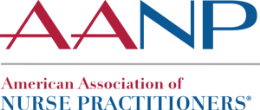AANP Member Spotlight: Playbook for Professional Continuous Glucose Monitoring

“I see this technology for diabetes tremendously changing people’s lives every single day.” — KC Arnold, ANP, ACNP, BC-ADM, FAANP
After becoming a diabetes educator and starting an insulin pump program on base during her time in the U.S. Air Force, KC Arnold returned to school to become a nurse practitioner (NP) to help people with diabetes. “I became the NP for an endocrinology group and treated people with diabetes for more than eight years,” she says. “After Hurricane Katrina, I founded The Diabetes Center in Ocean Springs, Mississippi, to provide better access to care for patients with diabetes.”
Now with three NPs on staff serving the Mississippi Gulf Coast, The Diabetes Center continues to make a difference for patients every day. “NPs can be on the cutting edge of technology,” Ms. Arnold says, “and we can become proficient in the technology that patients want to use, like continuous glucose monitoring [CGM] devices.”
How Technology Has Changed
Ms. Arnold has followed advances in diabetes technology for decades, including the advent of CGM. “Ultimately, it’s about offering patients what they need to help them better manage their diabetes,” she notes.
“Much has changed since the advent of the first CGM devices, including now their ability to work with insulin pumps, their availability at pharmacies and Medicare regulations. It’s truly a process in keeping up with how to get patients access to these devices and what device is right for their needs — but patients are asking about these tools, so we as clinicians need to be able to provide assistance.”
Different than personal CGM devices, professional CGM programs offer people with diabetes the ability to use CGM devices for short periods of time so both they and their diabetes care team can optimize diabetes self-management through user-generated data. With a professional CGM program, clinicians can download information from the patient’s device and pull it into the patient’s electronic health records (EHRs) digitally — even if patients aren’t in the office — to stay informed of daily blood sugar changes and to identify patterns in behavior.
“It’s the patterns we see that make a difference for the patient,” Ms. Arnold says. “It’s looking at what’s happening over a period of time to identify the source of a problem, and these reports offer a more complete picture of a patient’s history.”
However, research has found that integrating CGM technology into clinical practice presents various challenges, including concerns about time constraints, a lack of resources, not enough training or the need for a systematic approach to interpret data.
New Playbook to Assist in CGM Implementation
To address these clinician barriers to a professional CGM program, Ms. Arnold was a reviewer for the Professional Continuous Glucose Monitoring Implementation Playbook, made available through a partnership between the American Association of Diabetes Educators (AADE) and the American Association of Nurse Practitioners® (AANP).
This playbook is designed to outline the steps needed to set up a professional CGM program in your practice and offers case studies, details on how to work with patients on selecting a device and clinical guidelines. It also provides worksheets as hands-on tools to walk you through putting a program in place.
“It’s important to complete the worksheets to develop an internal process for your clinic — and to begin thinking about billing and coding,” says Ms. Arnold, noting that practices must purchase professional CGM devices up front so they can be available to patients when needed. “Mapping out the billing process before you begin will help prevent the delivery of non-covered services, and you can also speak with the device companies for help implementing a CGM program into your practice.”
Case Study: CGM for Commercial Drivers With Diabetes
Previously, Mississippi’s statewide policy prevented NPs from signing the Federal Motor Carrier Safety Administration’s Insulin-treated Diabetes Mellitus Assessment Form. This resulted in NPs like Ms. Arnold, who is also board certified in advanced diabetes management, not being able to properly assist patients in filling out the forms needed to keep their livelihood as commercial drivers.
So, she advocated to change state regulations. “Patients used to be required to have this form be signed by endocrinologist. Now, NPs can sign in our state and get people back to doing the job they need to do,” she says. “Everywhere I speak, I always bring up the point that patients safely using insulin to treat their diabetes can get a commercial driver’s license through the diabetes assessment form and then proceeding with the physical examination by a licensed medical examiner.”
The form specifically requires at least three months of ongoing blood glucose self-monitoring records measured with an electronic glucometer that stores all readings, records the date and
time of readings and from which data can be electronically downloaded. “With professional CGM programs, patients can be using a CGM device as this three-month log,” says Ms. Arnold, noting that this is just one way in which this technology can improve patient’s lives. “It’s amazing to see that, when I place a CGM device or insulin pump, patients’ chronic illness changes and, many times, can improve right in front of us to become better controlled.”

